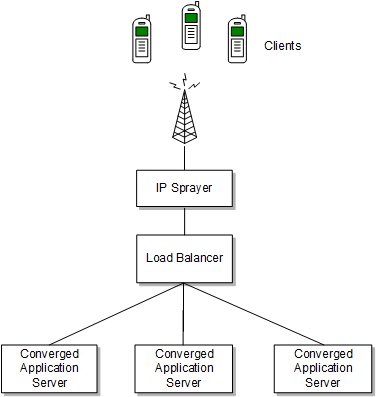Load Distribution Considerations
A load balancer improves the reliability and scalability of your Converged Application Server deployment. A load balancer distributes requests among the servers in your deployment and monitors their availability.
The following sections describe considerations related to exposing an external virtual IP (VIP) for the Converged Application Server deployment. These sections assume the use of an IP sprayer. However, your deployment may use other technology to perform the network dispatching function, such as the DNS Resource Records (RR) feature in the Linux operating system.
Single VIP Topology
In the simplest scenario, a single IP sprayer gates access to a Load Balancer which distributes messages to a cluster of engines, as shown in Figure 5-4.
Figure 5-4 SIngle Load Balancer Configuration

To configure Converged Application Server for use with a single IP sprayer, configure one or more network channels for each server, and configure the external address setting of each channel with the virtual IP address of the IP sprayer. The virtual IP address is the address exposed for the Converged Application Server installation to external clients.
In this configuration, Converged Application Server embeds the external address (or VIP) in SIP message system headers to ensure that clients can reach the cluster for subsequent replies.
Multiple VIP Topology
Multiple IP sprayers (or a multihomed node that functions as an IP sprayer) can be configured to provide several virtual IP addresses for a single Converged Application Server cluster.
To configure Converged Application Server for multiple VIPs, create a dedicated network channel for each IP sprayer or local server NIC. You then set the channel's external address to the virtual IP address of the IP sprayer to which the channel connects.
In this configuration, the route resolver associates a configured channel with the NIC used for originating SIP messages. The public address of the selected channel is then used for populating SIP system messages. See "Understanding the Route Resolver".